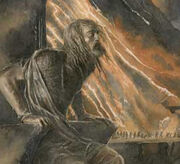The Narn i Hîn Húrin or, translated, The Lay of the Children of Húrin, is the second chapter of Part One of Unfinished Tales, telling the story of Húrin's three children, primarily Túrin Turambar. The history contained within the Lay was first compiled and retold by the poet Dírhaval, during the days of Eärendil.
A "lay" is a narrative poem generally intended to be sung.
See also The Children of Húrin.
Synopsis[]
The Narn (as it is commonly called) is a long story of all that happened to Húrin and his children Túrin Turambar and Niënor, after Húrin was cursed by Morgoth. In The Silmarillion, a complete but less detailed version of this story appears as "Of Túrin Turambar".[1]
The story elaborates on what is told of these characters in the published Silmarillion, starting with the childhood of Túrin, continuing through the captivity of his father in the Nírnaeth Arnoediad, and Túrin's exile in

Húrin in Thangorodrim
Doriath, to his time in Nargothrond, his unintentionally incestuous relationship with his sister Niënor, and ultimately ending with suicide by his sword Gurthang after having slain Glaurung.
As a point of reference regarding the names of the main characters: In this story, Túrin renames himself Turambar, meaning Master of Doom in the High-elven speech, with a vow to turn aside from the darkness that had ruled his early life. His sister Niënor is also called Níniel, meaning Maid of Tears. She is renamed by Turambar himself after he finds her alone and in distress in the woods. Only much later does he learn her real name and origins. The section ends with the Elves calling them by the names of Túrin Turambar Dagnir Glaurunga (as the slayer of the dragon Glaurung) and Niënor Níniel.
The story has some inconsistencies with The Silmarillion, and at points there are gaps and multiple versions: this is because Tolkien did not in fact complete the story during his lifetime, and his son Christopher Tolkien had to choose from all the work to create a consistent narrative for the The Silmarillion, else he or Guy Gavriel Kay invented additions to the story, believing certain materials insurmountable (though the choices were regretted in hindsight).
The story of the Narn continues in the Later Narn, which is also published in Unfinished Tales, and in The Wanderings of Húrin, a text which was found to be too different in style from rest of The Silmarillion, but which continues the Narn past Túrin's death and ends with Húrin's eventual release. This story was finally published in The War of the Jewels, a part of The History of Middle-earth. A book released in 2007 incorporated most of the elements of this story, entitled The Children of Húrin, though the latter differs in many details The Silmarillion's version.
Translations[]
| Foreign Language | Translated name |
| Armenian | Հարն ի հին Հարուն |
| Bulgarian Cyrillic | Нарн и Хин Хурин |
| Danish | Narn i Hîn Húrin |
| Greek | Ναρν-ι-χιν Χούριν |
| Japanese | ナルン・イ・ヒーン・フーリン |
| Macedonian Cyrillic | Нарн и Чхин Хурин |
| Russian | Нарн и хин Хурин |
| Serbian | Нарн и Хин Хурин (Cyrillic) Narn i Hin Húrin (Latin) |
| Thai | นาร์น อิ ฅีน ฮูริน |
| Ukrainian Cyrillic | Нарн і Гін Гурін |
References[]
- ↑ The Silmarillion, Quenta Silmarillion, Chapter XXI: "Of Túrin Turambar"
